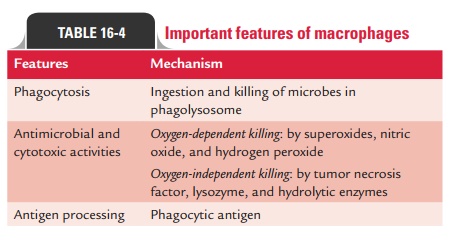Chapter: Microbiology and Immunology: Structure and Function Imune System
Antigen-presenting cells
Antigen-presenting cells
Antigen presenting cells (APCs) include (a) macrophages and (b) dendritic cells.
Macrophages
The mononuclear phagocytic system consists of monocytes circulating in the blood and macrophages in the tissues. The monocyte is considered a leukocyte in transit through the blood, which becomes a macrophage when fixed in a tissue. Monocytes and macrophages as well as granulocytes are able to ingest par-ticulate matter (microorganisms, cells, inert particles) and for this reason are said to have phagocytic functions. The phago-cytic activity is greater in macrophages, particularly after activa-tion by soluble mediators released during immune responses, than in monocytes. Differentiation of a monocyte into a tissue macrophage involves a number of changes as follows:
a) The cell enlarges 5–10 folds.
b) Its intracellular organelles increase in number and complexity.
c) It acquires increased phagocytic ability.
d) It produces higher levels of hydrolytic enzymes.
e) It begins to secrete a variety of soluble factors.
Macrophage-like cells serve different functions in different tissues and are named according to their tissue location. Examples include (a) alveolar macrophages in the lung, (b) histiocytes in connective tissues, (c) Kupffer cells in the liver, (d) mesangial cells in the kidney, (e) microglial cells in the brain, and (f) osteoclasts in the bone.
For their participation in the immune reaction, the macro-phages need to be stimulated and reach an “activated state.”
· Macrophages can be activated by various cytokines, compo-nents of the bacterial cell wall, and mediators of the inflam-matory response.
· Gamma interferon produced by helper T cells is a potent activator of macrophages and is secreted by various cells in response to appropriate stimuli. Bacterial lipopolysaccha-rides (endotoxin), bacterial peptidoglycan, and bacterial DNA are the substances that also activate macrophages.
· Activated macrophages are more potent than normal macro-phages in many ways, such as having greater phagocytic abil-ity and increased ability to kill ingested microbes. They are better APCs, and they activate T-cell response in a more effec-tive manner. By secreting various cytotoxic proteins, they help in eliminating a broad range of pathogens, including virus-infected cells, tumor cells, and intracellular bacteria.
Functions of macrophages: Macrophages perform threemain functions: (a) phagocytosis, (b) antigen presentation, and (c) cytokine production (Table 16-4).

Phagocytosis: Phagocytosis of bacteria, viruses, and other for-eign particles is the most important function of macrophages. The macrophages on their cell surfaces have Fc receptors that interact with Fc component of the IgG, thereby facilitating ingestion of the opsonized organisms. They also have recep-tors for C3b, another important opsonin. After ingestion, the phagosome containing the microbe fuses with a lysosome. The microbe within the phagolysosome is killed by reactive oxygen, reactive nitrogen compounds, and lysosomal enzymes.
Antigen presentation: After ingestion and degradation offoreign materials, the fragments of antigen are presented on the macrophage cell surface in conjunction with class II MHC proteins for interaction with the TCR of CD41 helper T cells. Degradation of the foreign protein is stopped following the association of antigen with the class II MHC proteins in the cytoplasm. This is followed by transportation of the complex to the cell surface by transporter proteins.
Cytokine production: Macrophages produce several cytokinesincluding the IL-1, TNF, and IL-8. IL-1 plays an important role in activation of helper T cells, while TNF plays as important mediator in inflammatory reactions. IL-8 attracts neutrophils and T cells to the site of infection.
Dendritic cells
Dendritic cells are so named because of their many long, nar-row processes that resemble neuronal dendrites, which make them very efficient at making contacts with foreign materials. They are primarily present in the skin (e.g., Langerhans cells) and the mucosa, from where they migrate
Four types of dendritic cells are known: (i) Langerhans cells, (ii) interstitial dendritic cells, (iii) myeloid cells, and (iv) lymphoid dendritic cells. All these cells constitutively express high levels of both class II MHC molecules and members of the costimulatory B7 family. Following microbial invasion or during inflamma-tion, mature and immature forms of Langerhans cells and inter-stitial dendritic cells migrate into draining lymph nodes, where they make the critical presentation of antigen to TH cells, which is required for the initiation of responses by those key cells.
Follicular dendritic cells
Follicular dendritic cells are similar to the dendritic cells except for their sites of presence and functions. These cells are pres-ent in B-cell-containing germinal centers of the follicles in the spleen and lymph nodes. These cells do not present antigen to helper T cells, but combine with antigen–antibody complexes by Fc receptors found on their surfaces.
Related Topics